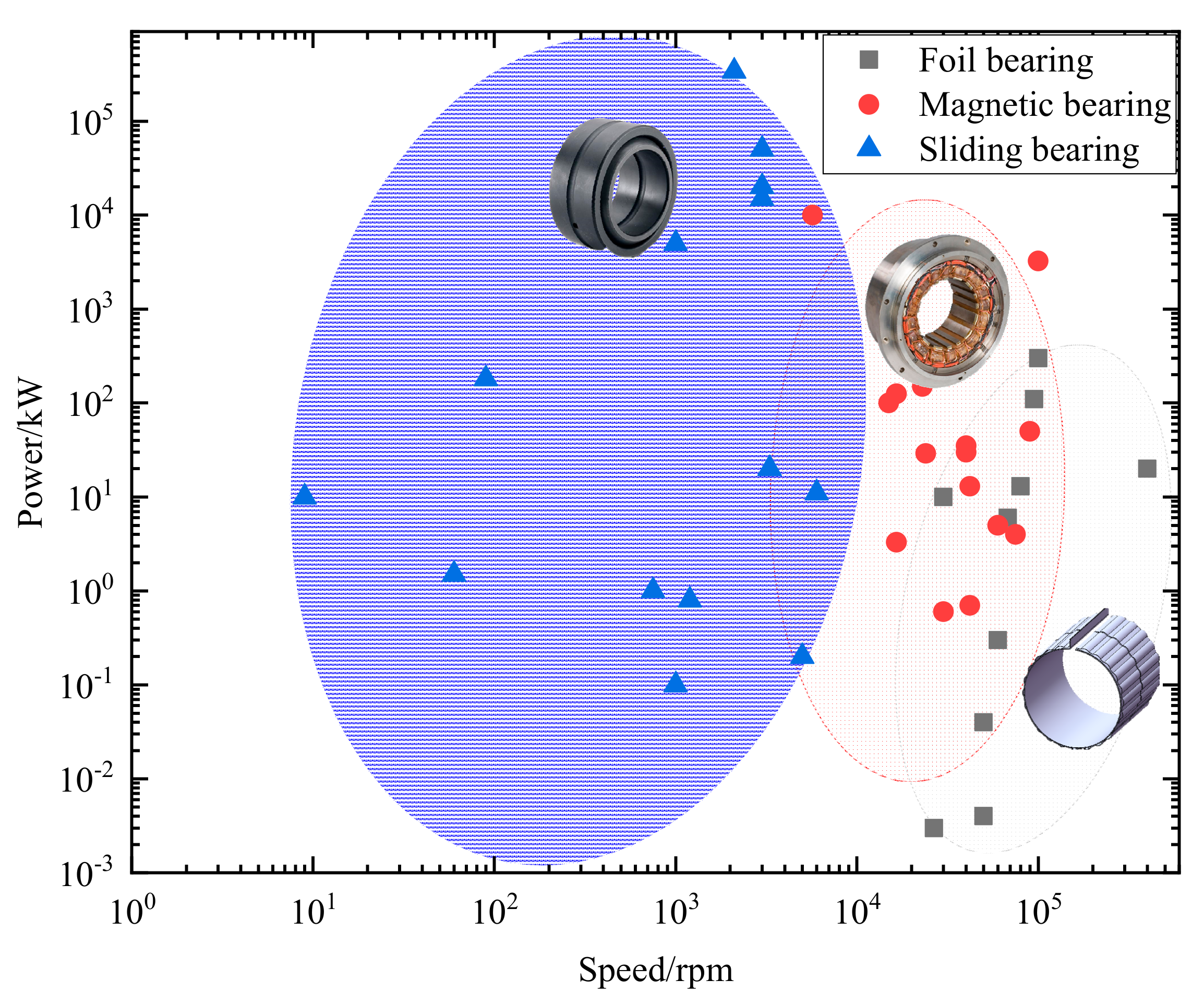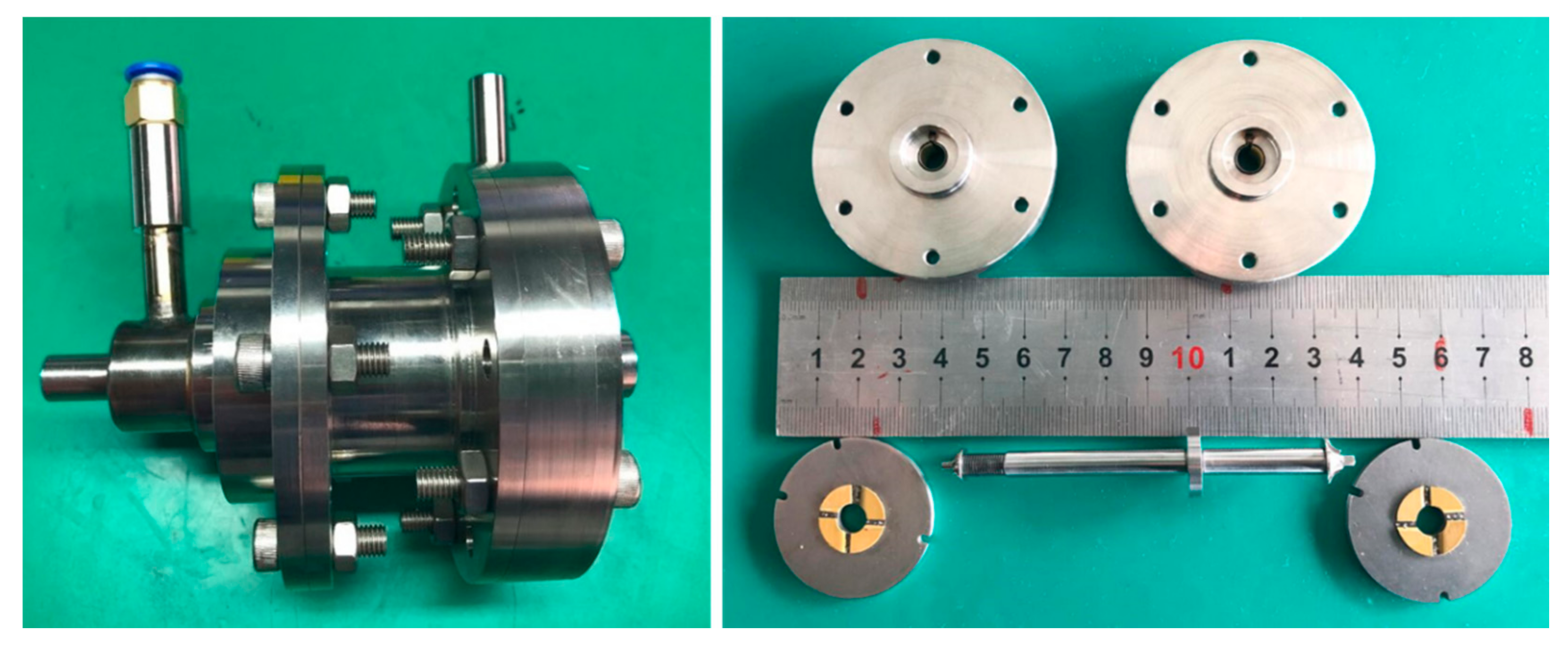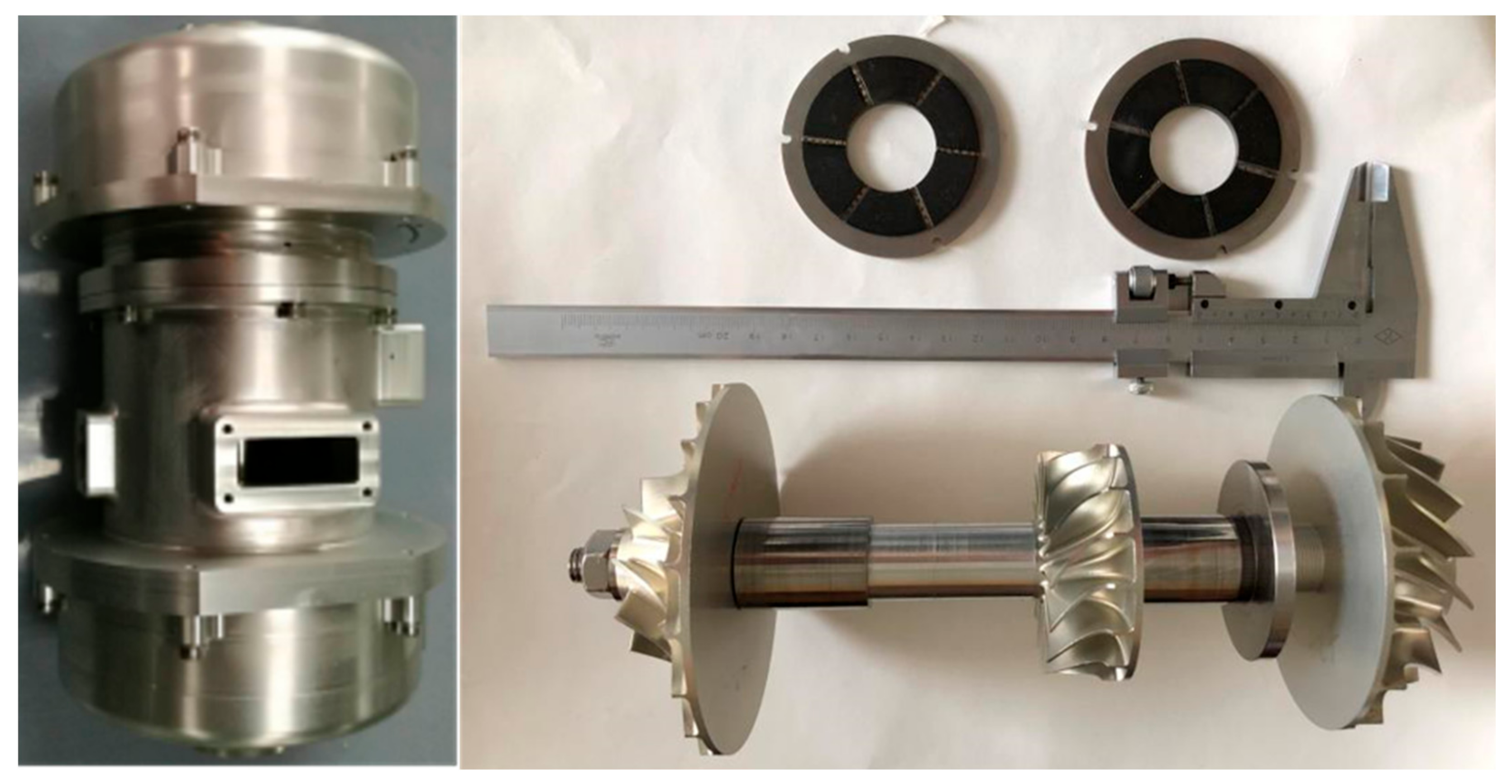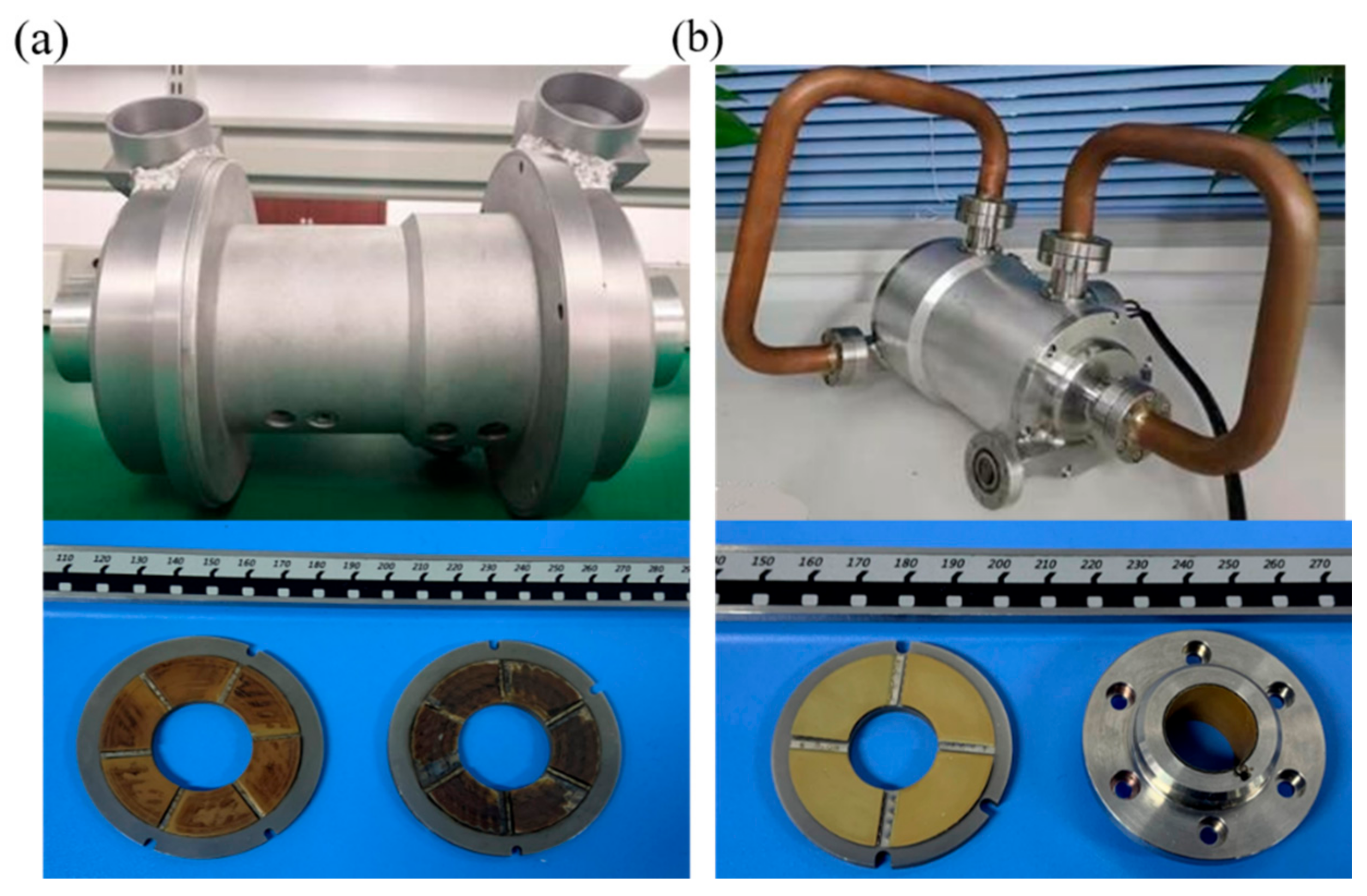Application of Gas Foil Bearings in China
Abstract
:1. Introduction
2. Applications of Gas Foil Bearings
2.1. Application in Low Temperature High-Speed Turbo-Expander
2.2. Application in Air Cycle Machine (ACM)
2.3. Application in Centrifugal Blowers
2.4. Application in Oil-Free Turbocharger
2.5. Application in High-Speed Gas Compressor
3. Challenges and Prospects
3.1. Load Capacity of Gas Foil Bearing
3.2. Design Criteria of Gas Foil Bearing
3.3. The Stability of Gas Foil Bearing
3.4. Thermal Management of Gas Foil Bearing
3.5. The Failure Protective Measures and Applications in Extreme Condition
4. Conclusions
Funding
Institutional Review Board Statement
Informed Consent Statement
Data Availability Statement
Conflicts of Interest
References
- Samanta, P.; Murmu, N.C.; Khonsari, M.M. The evolution of foil bearing technology. Tribol. Int. 2019, 135, 305–323. [Google Scholar] [CrossRef]
- San Andrés, L.; Ryu, K.; Kim, T.H. Thermal Management and Rotordynamic Performance of a Hot Rotor-Gas Foil Bearings System—Part I: Measurements. J. Eng. Gas Turbines Power 2011, 133, 10. [Google Scholar] [CrossRef]
- Emerson, T. Application of Foil Air Bearing Turbomachinery in Aircraft Enviormental Contral Systems. Control Syst. 1978, 100, 111. [Google Scholar] [CrossRef]
- Agrawal, G.L. Foil Gas Bearings for Turbomachinery; SAE Technical Paper; SAE International: Hamilton, OH, USA, 1990. [Google Scholar] [CrossRef]
- Mokhtar, M.O.A. Floating ring journal bearings: Theory, design and optimization. Tribol. Int. 1981, 14, 113–120. [Google Scholar] [CrossRef]
- Le Lez, S.; Arghir, M.; Frene, J. Static and Dynamic Characterization of a Bump-Type Foil Bearing Structure. J. Tribol. 2006, 129, 75–83. [Google Scholar] [CrossRef]
- Lee, Y.B.; Kim, T.H.; Kim, C.H.; Lee, N.S.; Choi, D.H. Dynamic characteristics of a flexible rotor system supported by a viscoelastic foil bearing (VEFB). Tribol. Int. 2004, 37, 679–687. [Google Scholar] [CrossRef]
- Agrawal, G. Foil Air/Gas Bearing Technology—An Overview. Am. Soc. Mech. Eng. 1997. [Google Scholar] [CrossRef] [Green Version]
- Le Lez, S.B.; Arghir, M.; Frene, J. A New Bump-Type Foil Bearing Structure Analytical Model. In Proceedings of the ASME Turbo Expo 2007, Power for Land, Sea, and Air, Montreal, QC, Canada, 14–17 May 2007; pp. 747–757. [Google Scholar]
- Oh, K.P.; Rohde, S.M.A. Theoretical Investigation of the Multileaf Journal Bearing. J. Appl. Mech. 1976, 43, 237. [Google Scholar] [CrossRef]
- Wang, L.Z.; Hou, Y.; Cui, M.X.; Chen, C.Z. Damping Evaluation of Foil Bearings. J. Xi’an Jiaotong Univ. 2006, 40, 40–44. (In Chinese) [Google Scholar]
- Chen, R.G.; Zhou, Q.; Hou, Y. Studies of self-acting journal foil bearing for miniature high speed turbo-expander. Lubr. Eng. 2010, 10, 13–17. (In Chinese) [Google Scholar]
- Feng, K.; Liu, W.; Yu, R.; Zhang, Z.M. Analysis and experimental study on a novel gas foil bearing with nested compression springs. Tribol. Int. 2017, 107, 65–76. [Google Scholar] [CrossRef]
- Song, J.-H.; Kim, D. Foil Gas Bearing with Compression Springs: Analyses and Experiments. J. Tribol. 2007, 129, 628–639. [Google Scholar] [CrossRef]
- Lai, T.; Guo, Y.; Zhao, Q.; Wang, Y.; Zhang, X.Q.; Hou, Y. Numerical and experimental studies on stability of cryogenic turbo-expander with protuberant foil gas bearings. Cryogenics 2018, 96, 62–74. [Google Scholar] [CrossRef]
- Lai, T.W.; Ma, B.; Zheng, Y.Q.; Hou, Y.; Zheng, Y.Q. Experiment investigation on stability of multi-decked protuberant foil gas journal bearings. J. Xi’an Jiaotong Univ. 2014, 3, 79–83. (In Chinese) [Google Scholar]
- Wang, W.; Li, X.J.; Zeng, Q.; Lai, T.W.; Hou, Y. Stability analysis for fully hydraodynamic gas-lubricated protuberant foil bearings in high speed turbomachinery. J. Xi’an Jiaotong Univ. 2017, 8, 84–89. (In Chinese) [Google Scholar]
- Łagodzinski, J.; Miazga, K.; Filipiak, I. Application of a compliant foil bearing for the thrust force estimation in the single stage radial blower. Open Eng. 2015, 5, 105–114. [Google Scholar]
- Kozanecka, D.; Kozanecki, Z.; Tkacz, E.; Łagodziński, J. Experimental research of oil-free support systems to predict the high-speed rotor bearing dynamics. Int. J. Dyn. Control 2015, 3, 9–16. [Google Scholar] [CrossRef] [Green Version]
- Lubell, D.; Dellacorte, C.; Stanford, M.; ASME. Test Evolution and Oil-Free Engine Experience of a High Temperature Foil Air Bearing Coating; American Society of Mechanical Engineers: New York, NY, USA, 2006. [Google Scholar]
- Hou, Y.; Xiong, Y.; Chen, C.Z. Experimental study of a new compliant foil air bearing with elastic support. Tribol. Trans. 2004, 47, 308–311. [Google Scholar] [CrossRef]
- Xiong, L.Y.; Wu, G.; Hou, Y.; Liu, L.Q.; Ling, M.F.; Chen, C.Z. Development of aerodynamic foil journal bearings for a high speed cryogenic turboexpander. Cryogenics 1997, 37, 221–230. [Google Scholar] [CrossRef]
- Sim, K.; Lee, Y.-B.; Kim, T.H. Rotordynamic Analysis of an Oil-Free Turbocharger Supported on Lobed Gas Foil Bearings—Predictions versus Test Data. Tribol. Trans. 2014, 57, 1086–1095. [Google Scholar] [CrossRef]
- Dellacorte, C. Stiffness and Damping Coefficient Estimation of Compliant Surface Gas Bearings for Oil-Free Turbomachinery. Tribol. Trans. 2011, 54, 674–684. [Google Scholar] [CrossRef]
- Howard, S.A. Rotordynamics and Design Methods of an Oil-Free Turbocharger. Tribol Trans. 1999, 42, 1. [Google Scholar] [CrossRef]
- Walton, J.F.; Tomaszewski, M.J.; Heshmat, H.; ASME. The Role of High Performance Foil Bearings in Advanced, Oil-Free, High-Speed Motor Driven Compressors; Rochester: New York, NY, USA, 2003; pp. 411–417. [Google Scholar]
- Sun, Y.H.; Cheng, W.J.; Chen, Z.F.; Zhuo, M.; Yu, L. Centrifugal Air Compressor Cooling Structure Driven by Ultra-High Speed Permanent Magnet Motor. C.N. 201310181042.5, 15 April 2015. [Google Scholar]
- McAuliffe, C.; Dziorny, P.J. Bearing Cooling Arrangement for Air Cycle machine. U.S. Patent 5113670A, 19 May 1992. [Google Scholar]
- Walton, J.F., II; Tomaszewski, M.J.; Heshmat, C.A. On the Development of an Oil-Free Electric Turbocharger for Fuel Cells. In Proceedings of the 2006 ASME Turbo Expo: Power for Land, Sea & Air, Barcelona, Spain, 1 January 2006. [Google Scholar]
- Sun, Y.G.; Yu, X.M.; Liu, H.T. Analysis of Dynamic Stiffness and Damping of Partial Porous Aerostatic Thrust Bearings. Appl. Mech. Mater. 2009, 875, 596–600. [Google Scholar] [CrossRef]
- Su, B.; Hou, Y.; Zhao, H.L.; Zhou, Q.; Chen, C.Z. Feasibility analysis on self-acting gas bearings of air condition system of plane. Cryogeni 2008, 3, 50–54. (In Chinese) [Google Scholar]
- Feng, K.; Zhao, X.; Guo, Z. Design and structural performance measurements of a novel multi-cantilever foil bearing. Proc. Inst. Mech. Eng. Part C J. Mech. Eng. Sci. 2015, 229, 1830–1838. [Google Scholar] [CrossRef]
- Feng, K.; Hu, J.; Liu, W.; Zhao, X.Y. Structural Characterization of a Novel Gas Foil Bearing with Nested Compression Springs: Analytical Modeling and Experimental Measurement. J. Eng. Gas Turbines 2016, 138. [Google Scholar] [CrossRef]
- Li, C.L.; Du, J.J.; Yao, Y.X. Study of load carrying mechanism of a novel three-pad gas foil bearing with multiple sliding beams. Mech. Syst. Signal Process. 2020, 135. [Google Scholar] [CrossRef]
- Luo, Y.X.; Zhang, J.Y. Analysis of gas film thermal characteristics of gas thrust bearing. Mach. Build. Autom. 2019, 48, 39–42. (In Chinese) [Google Scholar]
- Liu, S.X.; Ma, X.Z. Dynamic Properties Analysis of Compliant Foil Aerodynamic Bearings Based on Spring Model. Appl. Mech. Mater. 2011, 86, 252–255. [Google Scholar] [CrossRef]
- Du, K.Q.; Ma, X.Z. Research on the preparation and performances of MoS2-based lubricating coatings for gas bump foil bearings. Lubr. Eng. 2019, 44, 22–28. (In Chinese) [Google Scholar]
- Hou, A.P.; Lin, P.C.; Wang, R.; L, J.X.; Hu, B. Performance of air-dynamic lubrication thrust bearing and experiment. J. Aerosp. Power 2018, 33, 1510–1518. (In Chinese) [Google Scholar]
- Hou, Y.; Yang, S.J.; Chen, X.Y.; Chen, R.G.; Lai, T.W.; Chen, S.T. Application of compliant foil bearings in a cryogenic turboexpander. Journal of Harbin Eng. Univ. 2015, 4, 489–493. (In Chinese) [Google Scholar]
- Xiong, L.Y.; Hou, Y.; Wu, G.; Wang, B.C.; Chen, C.Z. Analytical study of plate foil journal gas bearings. J. Xi’an Jiaotong Univ. 1998, 9, 56–59. (In Chinese) [Google Scholar]
- Zhou, Q.; Hou, Y.; Cui, M.X.; Chen, C.Z. Analysis of new aerodynamic complaint foil thrust gas bearing. J. Xi’an Jiaotong Univ. 2006, 40, 1032–1035. (In Chinese) [Google Scholar]
- Hou, Y.; Zhu, Z.H.; Chen, C.Z. Comparative test on two kinds of new compliant foil bearing for small cryogenic turbo-expander. Cryogenics 2004, 44, 69–72. [Google Scholar] [CrossRef]
- Cui, M.X.; Hou, Y.; Wang, L.Z.; Chen, C.Z. On the calculation of structural stiffness of compliant bump foil bearing. Lubr. Eng. 2006, 5, 57–59. (In Chinese) [Google Scholar]
- Ma, B.; Sun, W.; Lai, T.W.; Zheng, Y.Q.; Chen, S.T.; Hou, Y. Experiment study on gas lubricated hydrodynamic bump type foil bearing. J. Xi’an Jiaotong Univ. 2014, 1, 118–122. (In Chinese) [Google Scholar]
- Zhou, Q.; Hou, Y.; Chen, R.G. Experimental research on compliant foil thrust bearings for high speed turbine expander. J. Xi’an Jiaotong Univ. 2012, 11, 49–52. (In Chinese) [Google Scholar]
- Lai, T.W.; Zheng, Y.Q.; Chen, S.T.; Hou, Y. Experimental study on the performance of multi-decked elastic support protuberant foil gas bearing. J. Northeast. Univ. 2014, 35, 415–418. (In Chinese) [Google Scholar]
- Lai, T.; Guo, Y.; Wang, W.; Hou, Y. Development and Application of Integrated Aerodynamic Protuberant Foil Journal and Thrust Bearing in Turboexpander. Int. J. Rotating Mach. 2017, 2017, 1–12. [Google Scholar] [CrossRef] [Green Version]
- Guo, Y.; Lai, T.W.; Zhao, Q.; Chu, Y.; Chen, S.T.; Hou, Y. Experimental study of multi-leaf foil bearing inhigh-speed turbo machinery. J. Xi’an Jiaotong Univ. 2020, 54, 40–45. (In Chinese) [Google Scholar]
- Guo, Y.; Hou, Y.; Zhao, Q.; Ren, X.H.; Lai, T.W. Application of multi-leaf foil bearings in high-speed turbo machinery. J. Adv. Mech. Des. Syst. Manuf. 2020, 14. [Google Scholar] [CrossRef]
- Sheng, C.C.; Yang, Y.; Xie, H.T.; Gao, W.H.; Luo, G.Q.; Chen, S.T.; Hou, Y. Development and application of aerodynamic foil bearings in high-speed turbo machinery of airborne ECS. Lubr. Eng. 2020, 45, 86–90. (In Chinese) [Google Scholar]
- Lv, P. Design and Experiment Study on Air Cycle Machine Rotor System Supported by Gas Foil Bearing. Master’s Thesis, Hunan University, Changsha, China, 2017. (In Chinese). [Google Scholar]
- Deng, W.M. Application of Air Bearing on Turbine Cooling Unit and its improvement. Equip. Manuf. Technol. 2014, 4, 140–142. (In Chinese) [Google Scholar]
- Shu, X.J.; Xu, G.; Zheng, Y.Q.; Cui, H.L.; Lan, H. Key Technologies for centrifugal blowers with foil bearings and high speed magnet motor. Compressor Blower Fan Technol. 2017, 59, 36–42. (In Chinese) [Google Scholar]
- Xie, Y.Q. Design and Experimental Study of an Oil Free Turbocharger. Master’s Thesis, Hunan University, Changsha, China, 2015. (In Chinese). [Google Scholar]
- Liu, W.H.; Lv, P.; Yu, R.; Feng, K. Design and experimental research of the oil-free turbocharger. J. Mech. Eng. 2018, 54, 129–136. (In Chinese) [Google Scholar] [CrossRef]
- Lin, H.; Geng, H.; Yu, L.; Zhou, J.; Li, H. Electromechanical Analysis and Experiment for a High-speed Permanent Magnet Synchronous Compressor Supported by Elastic Foil Bearing. In Proceedings of the 2019 IEEE/ASME International Conference on Advanced Intelligent Mechatronics (AIM), Hong Kong, China, 8–12 July 2019. [Google Scholar]
- Geng, H.P.; Cheng, W.J.; Yu, L. Cooling Structure of Motor-Driven High-Speed Centrifugal Air Compressor. CN:201110258998: A, 18 January 2012. (In Chinese). [Google Scholar]
- Deng, Z.H. Design and Experimental Study of an Oil-Free High Speed Compressor for Fuel Cell. Master’s Thesis, Hunan University, Changsha, China, 2016. (In Chinese). [Google Scholar]
- Jin, C.Y.; Xu, F.C.; Wu, M.L.; Fan, J.Y.; Xin, J. Calculation and Analysis of Air Bearing Centrifugal Compressor Rotor Dynamics for Fuel Cells. Automob. Parts 2020, 11, 6–9. (In Chinese) [Google Scholar]
- Xu, F.C.; Sun, Y.; Zhang, G.H.; Liu, Z.S. Effect of bump structural friction on the performance of bump foil bearing and rotor dynamic behavior: Experimental study. Proc. Inst. Mech. Eng. Part J J. Eng. Tribol. 2019, 233, 702–711. [Google Scholar] [CrossRef]








Publisher’s Note: MDPI stays neutral with regard to jurisdictional claims in published maps and institutional affiliations. |
© 2021 by the authors. Licensee MDPI, Basel, Switzerland. This article is an open access article distributed under the terms and conditions of the Creative Commons Attribution (CC BY) license (https://creativecommons.org/licenses/by/4.0/).
Share and Cite
Hou, Y.; Zhao, Q.; Guo, Y.; Ren, X.; Lai, T.; Chen, S. Application of Gas Foil Bearings in China. Appl. Sci. 2021, 11, 6210. https://doi.org/10.3390/app11136210
Hou Y, Zhao Q, Guo Y, Ren X, Lai T, Chen S. Application of Gas Foil Bearings in China. Applied Sciences. 2021; 11(13):6210. https://doi.org/10.3390/app11136210
Chicago/Turabian StyleHou, Yu, Qi Zhao, Yu Guo, Xionghao Ren, Tianwei Lai, and Shuangtao Chen. 2021. "Application of Gas Foil Bearings in China" Applied Sciences 11, no. 13: 6210. https://doi.org/10.3390/app11136210
APA StyleHou, Y., Zhao, Q., Guo, Y., Ren, X., Lai, T., & Chen, S. (2021). Application of Gas Foil Bearings in China. Applied Sciences, 11(13), 6210. https://doi.org/10.3390/app11136210





